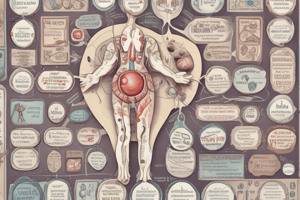Podcast
Questions and Answers
What are the two main types of diabetes mentioned in the text and their former names?
What are the two main types of diabetes mentioned in the text and their former names?
Type 1 diabetes (formerly insulin-dependent diabetes mellitus), Type 2 diabetes (formerly non– insulin-dependent diabetes mellitus)
What is the polypeptide hormone consisting of two peptide chains that are connected by disulfide bonds?
What is the polypeptide hormone consisting of two peptide chains that are connected by disulfide bonds?
Insulin
What is synthesized as a precursor that undergoes proteolytic cleavage to form insulin and C-peptide?
What is synthesized as a precursor that undergoes proteolytic cleavage to form insulin and C-peptide?
Proinsulin
What provides a better index of insulin levels than plasma insulin levels?
What provides a better index of insulin levels than plasma insulin levels?
What triggers insulin secretion most often?
What triggers insulin secretion most often?
Explain the difference between Type 1 and Type 2 diabetes in terms of age of onset, nutritional status at time of onset, and prevalence.
Explain the difference between Type 1 and Type 2 diabetes in terms of age of onset, nutritional status at time of onset, and prevalence.
Describe the process of insulin production and secretion by the β cells of the pancreas.
Describe the process of insulin production and secretion by the β cells of the pancreas.
What are the genetic predispositions and defects associated with Type 1 and Type 2 diabetes, respectively?
What are the genetic predispositions and defects associated with Type 1 and Type 2 diabetes, respectively?
Explain the structure and synthesis of insulin and C-peptide in the context of insulin and insulin analogs.
Explain the structure and synthesis of insulin and C-peptide in the context of insulin and insulin analogs.
Discuss the factors that regulate insulin secretion and the primary trigger for insulin secretion.
Discuss the factors that regulate insulin secretion and the primary trigger for insulin secretion.
Flashcards are hidden until you start studying




